Key Ecological and Cultural Characteristics of Homestead Windbreak Forest Landscapes in Okinawa, Japan
Abstract
1. Introduction
- What are the defining ecological and cultural characteristics of homestead windbreak forest landscapes in Okinawa, and how do these features compare to similar agroforestry systems across Japan and globally?
- What historical and environmental factors influenced the origin and development of the Fukugi tree windbreak system in Okinawa, particularly from its inception during the Ryukyu Kingdom era to its current state, and how has this system supported sustainable rural landscapes over time?
2. Survey Area and Methods
2.1. Survey Area


2.2. Survey Methods of Village Homestead Windbreak Forests
2.3. Survey Methods of Naturally Regenerating Fukugi Trees Outside Villages
2.4. Data Analysis
3. Results
3.1. Homestead Windbreak Tree Species Composition in Sonai Village
3.2. Homestead Windbreak Tree Species Composition in Hoshitate Village
3.3. Fukugi Groups in the Mountains of Iriomote Island
4. Discussion
4.1. Traditional Island Village Homestead Windbreaks in Okinawa
4.2. Evolution of the Fukugi Windbreak System
4.3. Contribution to Ecosystem Services and Cultural Heritage
5. Conclusions
Author Contributions
Funding
Data Availability Statement
Conflicts of Interest
References
- Taylor, K.; Lennon, J. Cultural landscapes: A bridge between culture and nature? Int. J. Heritage Stud. 2011, 17, 537–554. [Google Scholar] [CrossRef]
- Maass, P. The cultural context of biodiversity conservation. In Valuation and Conservation of Biodiversity; Markussen, M., Buse, R., Garrelts, H., Costa, M.A.M., Menzel, S., Marggraf, R., Eds.; Springer: Berlin/Heidelberg, Germany, 2005. [Google Scholar] [CrossRef]
- Kim, S.; Li, G.; Son, Y. The Contribution of Traditional Ecological Knowledge and Practices to Forest Management: The Case of Northeast Asia. Forests 2017, 8, 496. [Google Scholar] [CrossRef]
- Berkes, F.; Colding, J.; Folke, C. Rediscovery of traditional ecological knowledge as adaptive management. Ecol. Appl. 2000, 10, 1251–1262. [Google Scholar] [CrossRef]
- Youn, Y.-C.; Liu, J.; Sakuma, D.; Kim, K.; Masahiro, I.; Shin, J.-H.; Yuan, J. Northeast Asia. In Traditional Forest-Related Knowledge; Parrotta, J.A., Trosper, R.L., Eds.; Springer: Dordrecht, The Netherlands, 2012; pp. 281–313. ISBN 978-94-007-2143-2. [Google Scholar]
- Liang, L.; Shen, L.; Yang, W.; Yang, X.; Zhang, Y. Building on traditional shifting cultivation for rotational agroforestry experiences from Yunnan, China. For. Ecol. Manag. 2009, 257, 1989–1994. [Google Scholar] [CrossRef]
- Herrmann, T.M.; Torri, M.-C. Changing forest conservation and management paradigms: Traditional ecological knowledge systems and sustainable forestry: Perspectives from Chile and India. Int. J. Sustain. Dev. World Ecol. 2009, 16, 392–403. [Google Scholar] [CrossRef]
- Bürgi, F.; Gimmi, U.; Stuber, M. Assessing traditional knowledge on forest uses to understand forest ecosystem dynamics. For. Ecol. Manag. 2013, 289, 115–122. [Google Scholar] [CrossRef]
- Yuan, J.; Wu, Q.; Liu, J. Understanding indigenous knowledge in sustainable management of natural resources in China: Taking two villages from Guizhou Proince as a case. For. Policy Econ. 2012, 22, 47–52. [Google Scholar]
- Ramakrishnan, P.S. Traditional forest knowledge and sustainable forestry: A north-east India perspective. For. Ecol. Manag. 2007, 249, 91–99. [Google Scholar] [CrossRef]
- Dudley, N.; Bhagwat, S.A.; Higgins-Zogib, L.; Lassen, B. Conservation of Biodiversity in Sacred Natural Sites in Asia and Africa: A Review of the Scientific Literature. In Sacred Natural Sites: Conserving Nature and Culture; Verschuuren, B., McNeely, J., Ovieda, G., Wild, R., Eds.; Earthscan: London, UK, 2010. [Google Scholar]
- Zannini, P.; Frascaroli, F.; Nascimbene, J.; Persico, A.; Halley, J.M.; Stara, K.; Midolo, G.; Chiarucci, A. Sacred natural sites and biodiversity conservation: A systematic review. Biodivers. Conserv. 2021, 30, 3747–3762. [Google Scholar] [CrossRef]
- Sullivan, M.K.; Browne, L.; Zuluaga, J.C.P.; Liu, J.; Surendra, A.; Estrada-Villegas, S. Sacred forest biodiversity conservation: Ameta-analysis. Conserv. Sci. Pract. 2024, 6, e13055. [Google Scholar] [CrossRef]
- Gao, H.; Ouyang, Z.; Chen, S.; Koppen, C.S.A. Role of culturally protected forests in biodiversity conservation in Southeast China. Biodivers. Conserv. 2013, 22, 531–544. [Google Scholar] [CrossRef]
- Yuan, J.; Liu, J. Fengshui forest management by the Buyi ethnic minority in China. For. Ecol. Manag. 2009, 257, 2002–2009. [Google Scholar] [CrossRef]
- Coggins, C.; Chevrier, J.; Dwyer, M.; Longway, L.; Xu, L.; Tiso, P.; Li, Z. Village Fengshui forests of southern China: Culture, history, and conservation status. Asia Netw. Exch. 2012, 19, 52–67. [Google Scholar] [CrossRef]
- Coggins, C.; Minor, J. Fengshui forests as a socio-natural reservoir in the face of climate change and environmental transformation. Asia Pac. Perspect. 2018, 15, 4–29. [Google Scholar]
- Wartman, P.; Van Acker, R.; Martin, R.C. Temperate Agroforestry: How Forest Garden Systems Combined with People-Based Ethics Can Transform Culture. Sustainability 2018, 10, 2246. [Google Scholar] [CrossRef]
- Piras, F.; Fiore, B.; Santoro, A. Small Cultural Forests: Landscape Role and Ecosystem Services in a Japanese Cultural Landscape. Land 2022, 11, 1494. [Google Scholar] [CrossRef]
- Koh, I.; Kim, S.; Lee, D. Effects of Bibosoop plantation on wind speed, humidity, and evaporation in a traditional agricultural landscape of Korea: Field measurements and modeling. Agric. Ecosyst. Environ. 2010, 135, 294–303. [Google Scholar] [CrossRef]
- Wan, R.; Wan, R.; Qiu, Q. Progress and Prospects of Research on the Impact of Forest Therapy on Mental Health: A Bibliometric Analysis. Forests 2024, 15, 1013. [Google Scholar] [CrossRef]
- Bielinis, E.; Bielinis, L.; Krupińska-Szeluga, S.; Łukowski, A.; Takayama, N. The Effects of a Short Forest Recreation Program on Physiological and Psychological Relaxation in Young Polish Adults. Forests 2019, 10, 34. [Google Scholar] [CrossRef]
- Nair, P.K.R. Agroforestry Systems in the Tropics; Springer: Dordrecht, The Netherlands, 1989. [Google Scholar]
- Huang, L.; Tian, L.; Zhou, L.; Jin, C.; Qian, S.; Jim, C.Y.; Lin, D.; Zhao, L.; Minor, J.; Coggins, C.; et al. Local cultural beliefs and practices promote conservation of large old trees in an ethnic minority region in southwestern China. Urban For. Urban Green. 2020, 49, 126584. [Google Scholar] [CrossRef]
- Motiejūnaitė, J.; Børja, I.; Ostonen, I.; Bakker, M.R.; Bjarnadottir, B.; Brunner, I.; Iršėnaitė, R.; Mrak, T.; Oddsdóttir, E.S.; Lehto, T. Cultural ecosystem services provided by the biodiversity of forest soils: A European review. Geoderma 2019, 343, 19–30. [Google Scholar] [CrossRef]
- O’Brien, L.E.; Urbanek, R.E.; Gregory, J.D. Ecological functions and human benefits of urban forests. Urban For. Urban Green. 2022, 75, 127707. [Google Scholar] [CrossRef]
- Kalaba, F.K. A conceptual framework for understanding forest socio-ecological systems. Biodivers. Conserv. 2014, 23, 3391–3403. [Google Scholar] [CrossRef]
- Takeuchi, K.; Ichikawa, K.; Elmqvist, T. Satoyama landscape as social-ecological system: Historical changes and future perspective. Curr. Opin. Environ. Sustain. 2016, 19, 30–39. [Google Scholar] [CrossRef]
- Whang, B.-C.; Lee, M.W. Landscape ecology planning principles in Korean Feng-shui, Bi-bo woodlands and ponds. Landsc. Ecol. Eng. 2006, 2, 147–162. [Google Scholar] [CrossRef]
- Guan, C. Study on knowledge and practice on function of conserving water and soil of forests in ancient China. Sci. Soil Water Conserv. 2004, 2, 105–110. (In Chinese) [Google Scholar]
- Salvatori, E.; Pallante, G. Forests as Nature-Based Solutions: Ecosystem Services, Multiple Benefits and Trade-Offs. Forests 2021, 12, 800. [Google Scholar] [CrossRef]
- Yazawa, T. On the distribution of wind-mantels in the vicinity of Tokyo. Geogr. Rev. Jpn. 1936, 12, 4766, (In Japanese with English abstract). [Google Scholar] [CrossRef]
- Chen, B.; Liang, L. Old-growth trees in homesteads in Ryukyu Archipelago, Japan: Uses, management, and conservation. Small-Scale For. 2020, 19, 39–56. [Google Scholar] [CrossRef]
- Okada, M.; Nakashima, Y.; Yanagihara, A.; Fujiwara, K. Premises Forest in Shonai Plain (III). Tohoku J. For. Sci. 1998, 3, 2125, (In Japanese with English abstract). [Google Scholar]
- Oka, S.; Aoyama, T.; Ogawa, H.; Uemoto, T. Windbreak Climate Landscapes: Homestead and Windbreak Forests Protecting Lives; Kokon Syoin: Tokyo, Japan, 2023; p. 224. (In Japanese) [Google Scholar]
- Natsume, M. Wind condition analysis of Japanese rural landscapes in the 19th century: A case study of Kichijoji Village in Musashino Upland. Int. J. Geo-Inf. 2019, 8, 396. [Google Scholar] [CrossRef]
- Aoki, H.; Kuroyanagi, A. Study on the located situation of Mizuya/Mizuka and its trans formation in the Arakawa basin. J. Arch. Tecture Plan. 2015, 80, 851861, (In Japanese with English abstract). [Google Scholar]
- Chen, B.; Nakama, Y.; Kurima, G. Layout and composition of house-embracing trees in an island Feng shui village in Okinawa, Japan. Urban For. Urban Green. 2008, 7, 53–61. [Google Scholar] [CrossRef]
- Irei, A.; Miryeganeh, M.; Tamashiro, M.; Saze, H.; Urasaki, N.; Tarora, K. Development of a male specific genetic marker for Garcinia subelliptica Merr. tree. J. For. Res. 2021, 26, 222–229. [Google Scholar] [CrossRef]
- Chen, B. Fukugi Trees in Ryukyu Archipelago (Ryukyu Retto no Fukugi Namiki); Nanpo Shinsha: Kagoshima, Japan, 2024; p. 253. (In Japanese) [Google Scholar]
- Ando, T.; Ono, K. A study on changes of residential environment in villages of the middle and northern part of Okinawa Island: Transformation of Yashikirin (house enclosure with trees) in l945, 1972–1974 and 2003. J. Hous. Res. Found 2006, 33, 417–428. [Google Scholar]
- Koshina, Y. Transition of woodlands around farmyards at settlements in the Northwestern Part of the Kanto Plain. J. Geogr. 2023, 132, 197–216, (In Japanese with English abstract). [Google Scholar] [CrossRef]
- Kotaka, N.; Preble, J.; Saito, K.; Toguchi, Y.; Kudaka, M.; Sakoda, T.; Yagihashi, T. Recent nest tree use by the critically endangered Okinawa woodpecker in relation to forest age and two exotic forest pests. J. For. Res. 2021, 26, 192–200. [Google Scholar] [CrossRef]
- Brown, J.H.; Lomolino, M.V. Biogeography; Sinauer Associates Publishers: Sunderland, MA, USA, 1998. [Google Scholar]
- Okinawa Prefecture, Overview of Yaeyama Region. Available online: https://www.pref.okinawa.lg.jp/ (accessed on 19 November 2024). (In Japanese).
- Taketomi Regional Demographic Survey. 31 March 2023. Available online: https://www.town.taketomi.lg.jp/userfiles/files/jinko_list_R5_3.pdf (accessed on 23 December 2024). (In Japanese).
- Geospatial Information Authority of Japan. Maps of Japan on the Web. Available online: https://maps.gsi.go.jp›index_m.html (accessed on 23 December 2024). (In Japanese)
- Chen, B.; Nakama, Y. Distribution of Old Fukugi (Garcinia subelliptica) Trees in traditional cultural landscapes in Okinawa Islands in Japan. J. Jpn. Soc. Coast. For. 2011, 10, 79–88. [Google Scholar]
- Chen, B.; Nakama, Y.; Zhang, Y. Traditional village tree landscapes: Tourists’ attitudes and preferences for conservation. Tour. Manag. 2017, 59, 652–662. [Google Scholar] [CrossRef]
- Hirata, E. On the estimation of the age of an old Garcinia subelliptica tree. In On the Garcinia Subelliptica Trees in Okinawa; N.p.o. Body Corporate of Yamabiko ed.; Okinawa Green Promotion Committee: Naha, Japan, 2006; pp. 41–46, (In Japanese with English abstract). [Google Scholar]
- Bettinger, P.; Boston, K.; Siry, J.P.; Grebner, D.L. Forest Management and Planning, 2nd ed.; Academic Press: Cambridge, MA, USA, 2017; p. 349. [Google Scholar]
- Bagley, W.T. 33. Agroforestry and windbreaks. Agric. Ecosyst. Environ. 1988, 22–23, 583–591. [Google Scholar] [CrossRef]
- Weiwei, L.; Wenhua, L.; Moucheng, L.; Fuller, A.M. Traditional agroforestry systems: One type of globally important agricultural heritage systems. J. Resour. Ecol. 2014, 5, 306–313. [Google Scholar] [CrossRef]
- Hirahara, S. Evaluation of a Structure Providing Cultural Ecosystem Services in Forest Recreation: Quantitative Text Analysis of Essays by Participants. Forests 2021, 12, 1546. [Google Scholar] [CrossRef]
- Suzuki, K.F.; Kobayashi, Y.; Seidl, R.; Senf, C.; Tatsumi, S.; Koide, D.; Azuma, W.A.; Higa, M.; Koyanagi, T.F.; Qian, S.; et al. The potential role of an alien tree species in supporting forest restoration: Lessons from Shiretoko National Park, Japan. For. Ecol. Manag. 2021, 493, 119253. [Google Scholar] [CrossRef]
- Chen, B.; Akamine, H. Distribution and utilization of homestead windbreak Fukugi (Garcinia subelliptica Merr.) trees: An ethnobotanical approach. J. Ethnobiol. Ethnomedicine 2021, 17, 11. [Google Scholar] [CrossRef] [PubMed]
- Lin, F.; Luo, B.; Cheng, Z.; Li, P.; Long, C. Ethnobotanical study on Garcinia (Clusiaceae) in China. Acta Soc. Bot. Pol. 2021, 90, 9012. [Google Scholar] [CrossRef]
- Fang, J.; Guo, Z.; Hu, H.; Kato, T.; Muraoka, H.; Son, Y. Forest biomass carbon sinks in East Asia, with special reference to the relative contributions of forest expansion and forest growth. Glob. Chang. Biol. 2014, 20, 2019–2030. [Google Scholar] [CrossRef]
- Nair, P.R. The coming of age of agroforestry. J. Sci. Food Agric. 2007, 87, 1613–1619. [Google Scholar] [CrossRef]
- Plieninger, T.; Bieling, C.; Fagerholm, N.; Byg, A.; Hartel, T.; Hurley, P.; López-Santiago, C.A.; Nagabhatla, N.; Oteros-Rozas, E.; Raymond, C.M.; et al. The role of cultural ecosystem services in landscape management and planning. Curr. Opin. Environ. Sustain. 2015, 14, 28–33. [Google Scholar] [CrossRef]
- Ota, M. Current Status and Challenges for Forest Commons (Iriai Forest) Management in Japan: A Focus on Forest Producers’ Cooperatives and Authorized Neighborhood Associations. Forests 2023, 14, 572. [Google Scholar] [CrossRef]
- Takahashi, S. Regionalizing the Local, Localizing the Region: The Okinawa Struggle and Place-Based Identity. Ph.D. Thesis, The Australia National University, Canberra, Australia, 22 September 2015. [Google Scholar]
- Chen, B. Visitors’ perceptions of traditional homestead windbreaks from user-generated comments. Urban For. Urban Green. 2023, 85, 127970. [Google Scholar] [CrossRef]
- Sato, N.; Tseng, Y.L.; Yeh, S.S.; Huan, T.C. Forest as a venue for recreational therapy in Japan. In Nature Tourism; Routledge: London, UK, 2017; pp. 196–207. [Google Scholar]
- Figal, G. Between war and tropics: Heritage tourism in postwar Okinawa. Public Hist. 2008, 30, 83–107. [Google Scholar] [CrossRef]
- Kakazu, H. Island sustainability and inclusive development: The case of Okinawa (Ryukyu) Islands. J. Mar. Isl. Cult. 2018, 7, 1–36. [Google Scholar] [CrossRef]
- Abe, T.; Watari, Y.; Imai, N. Ecological management of insular forests: Conservation of endangered species and native ecosystems in Ryukyu Archipelago. J. For. Res. 2021, 26, 169–170. [Google Scholar] [CrossRef]
- Sato, N.; Hashimoto, T. The decrease trend and the reasons of succession of windbreaks in settlements on the composite fan. J. Archit. Plan. 2016, 81, 889898, (In Japanese with English abstract). [Google Scholar]
- Di Pirro, E.; Sallustio, L.; Castellar, J.A.C.; Sgrigna, G.; Marchetti, M.; Lasserre, B. Facing Multiple Environmental Challenges through Maximizing the Co-Benefits of Nature-Based Solutions at a National Scale in Italy. Forests 2022, 13, 548. [Google Scholar] [CrossRef]
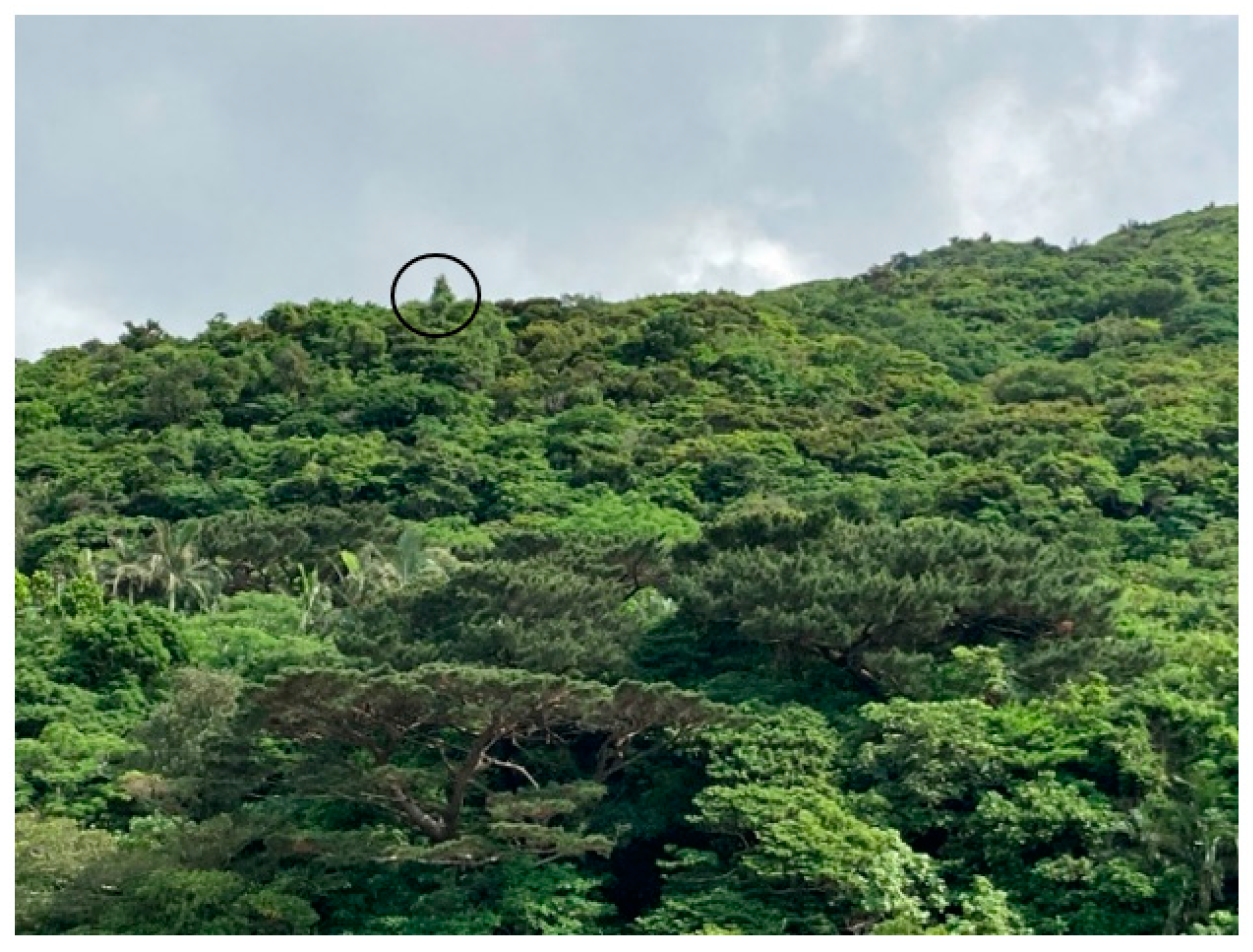
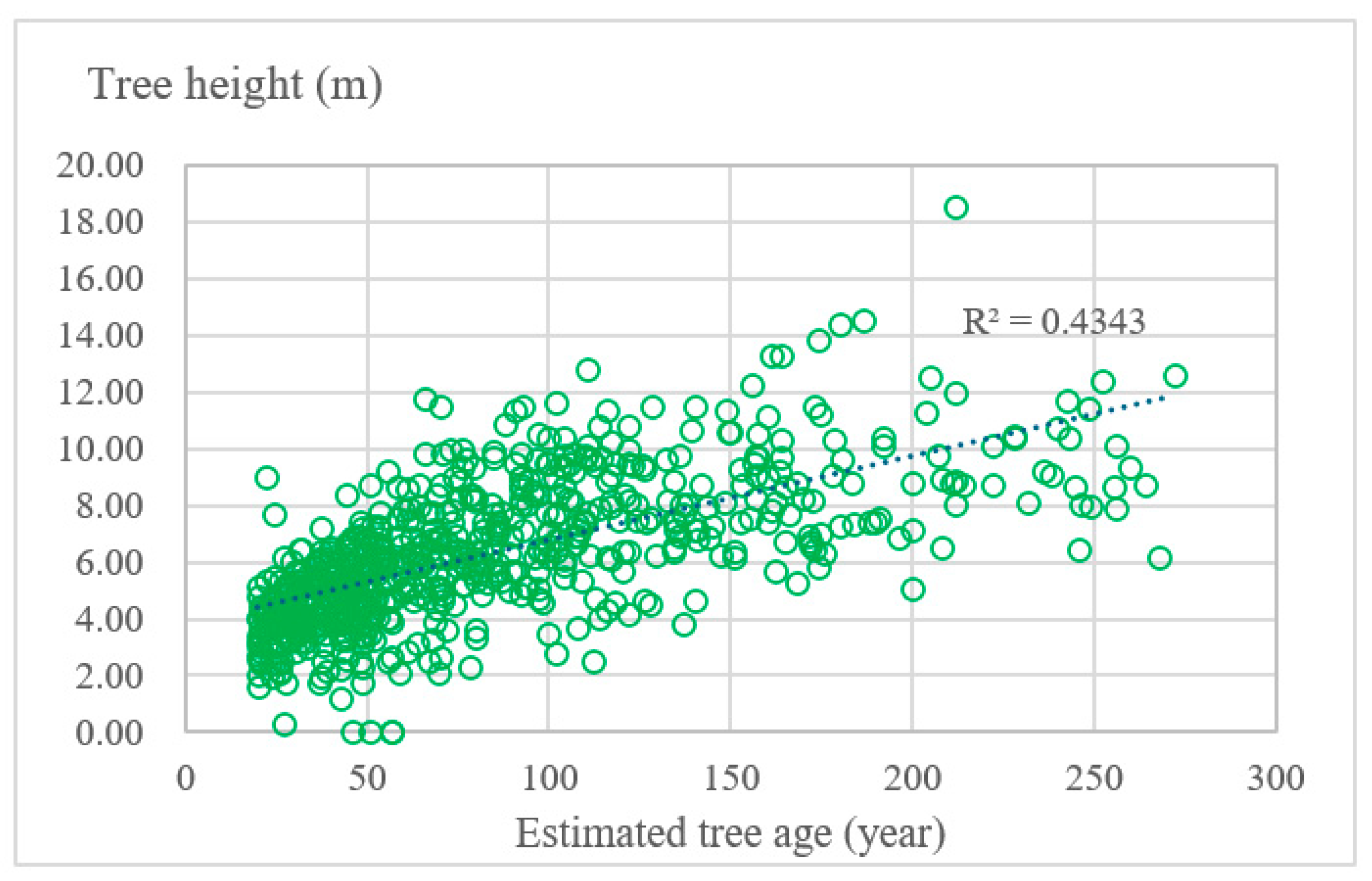
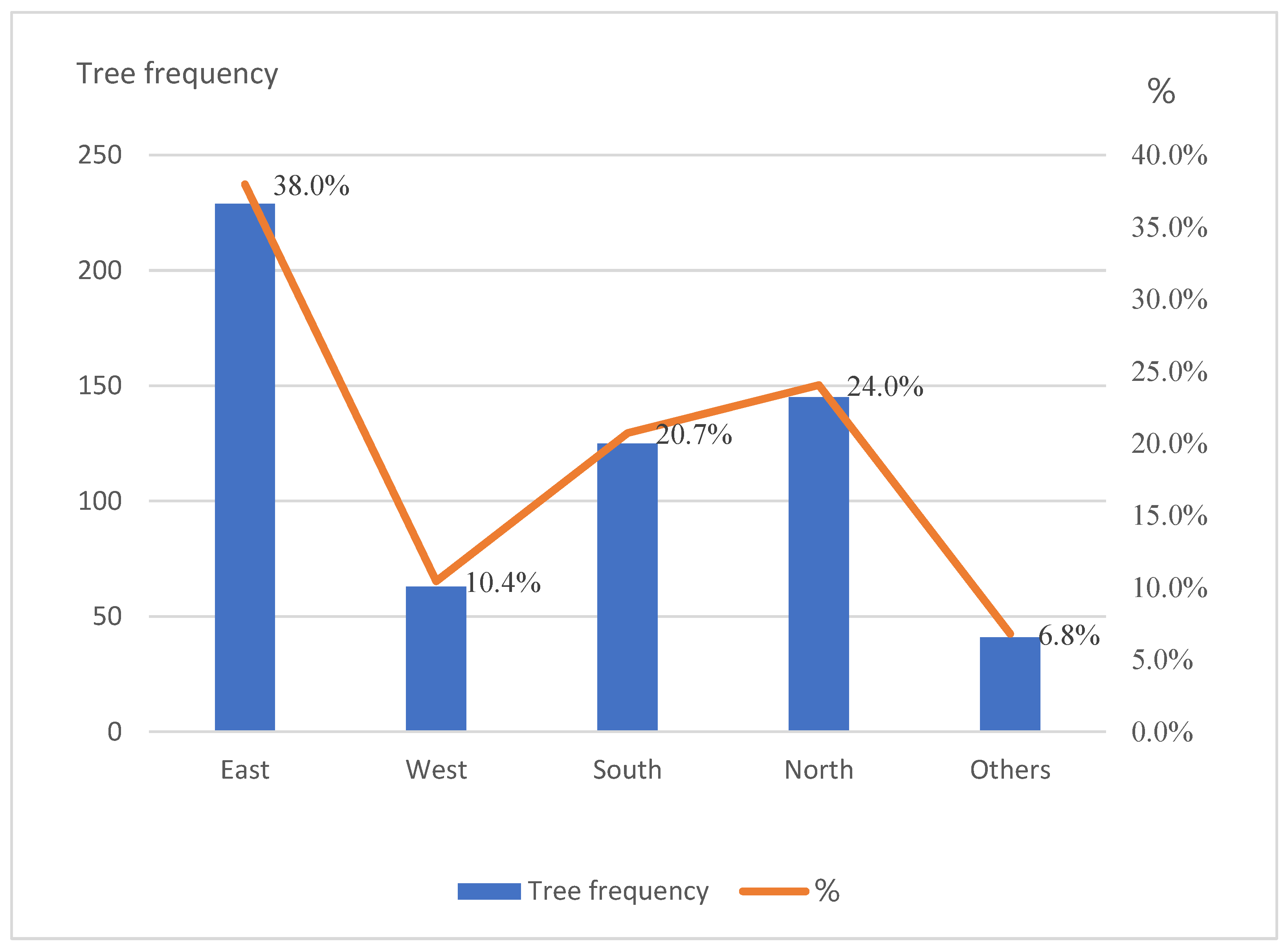
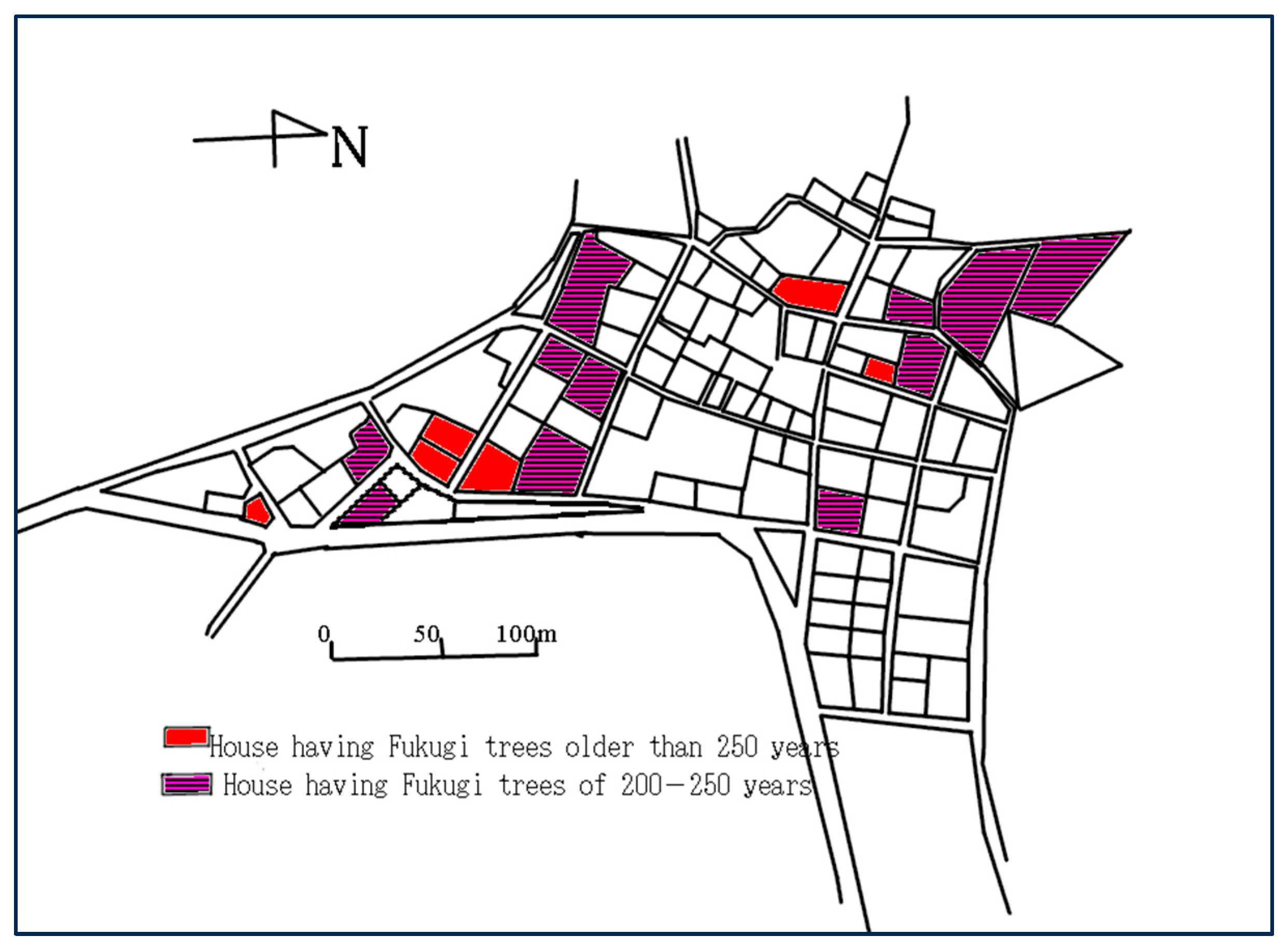

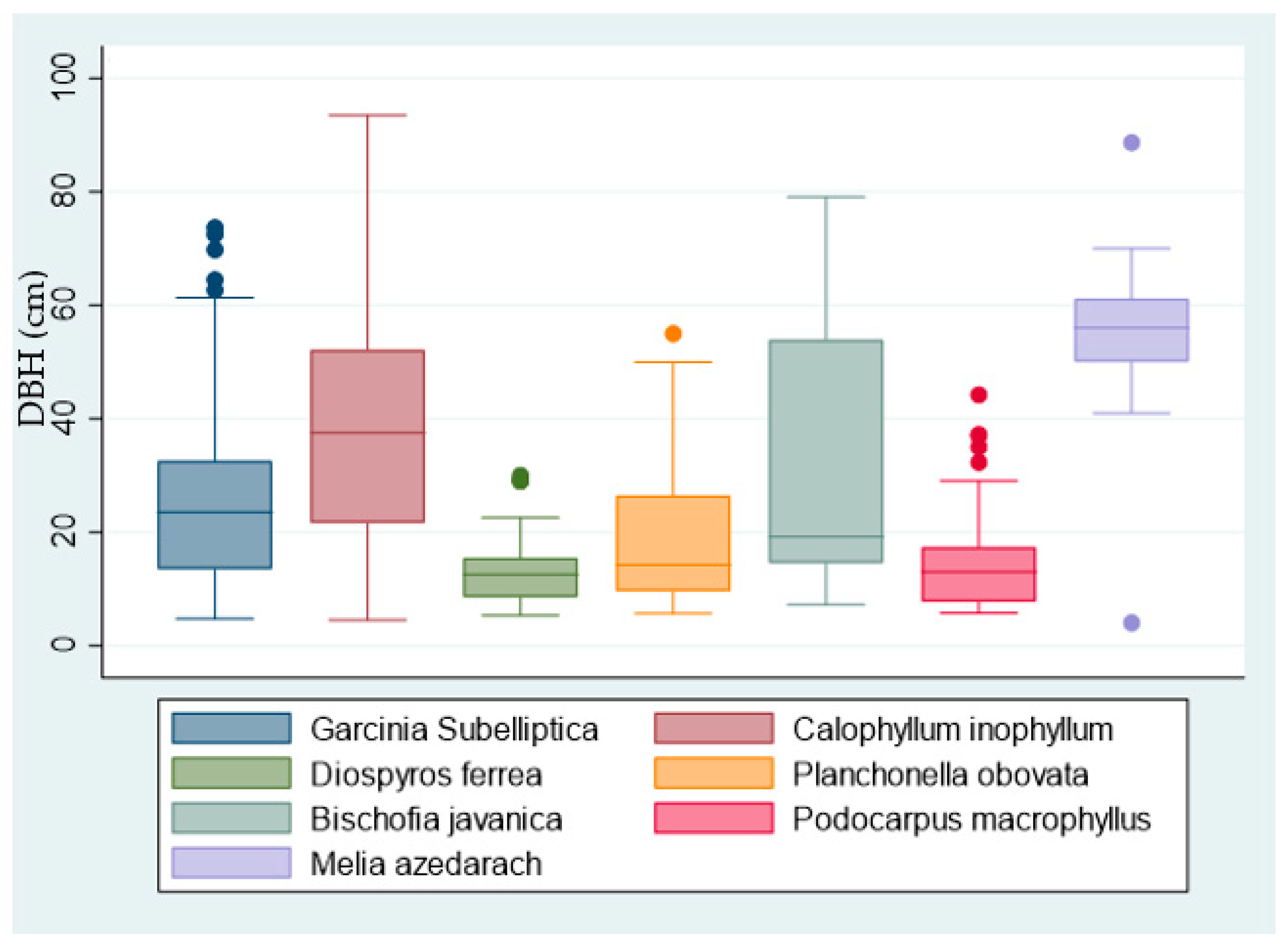
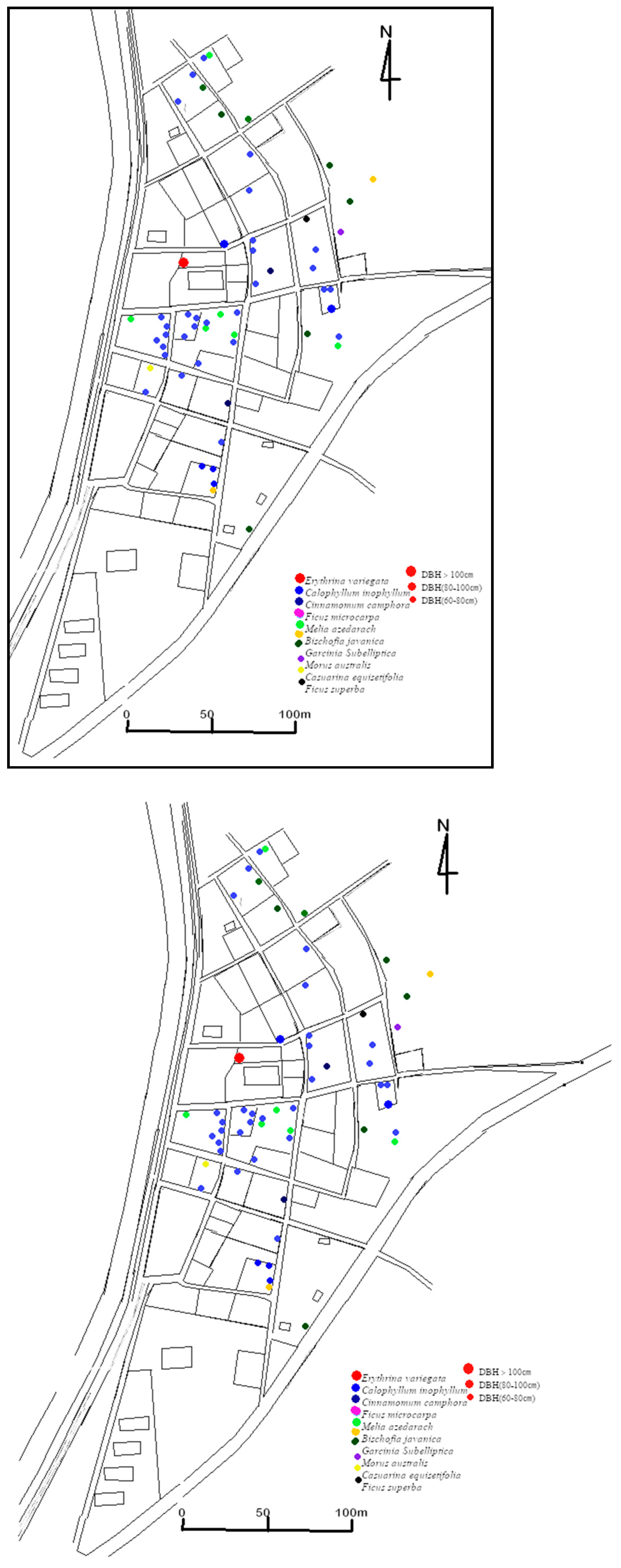
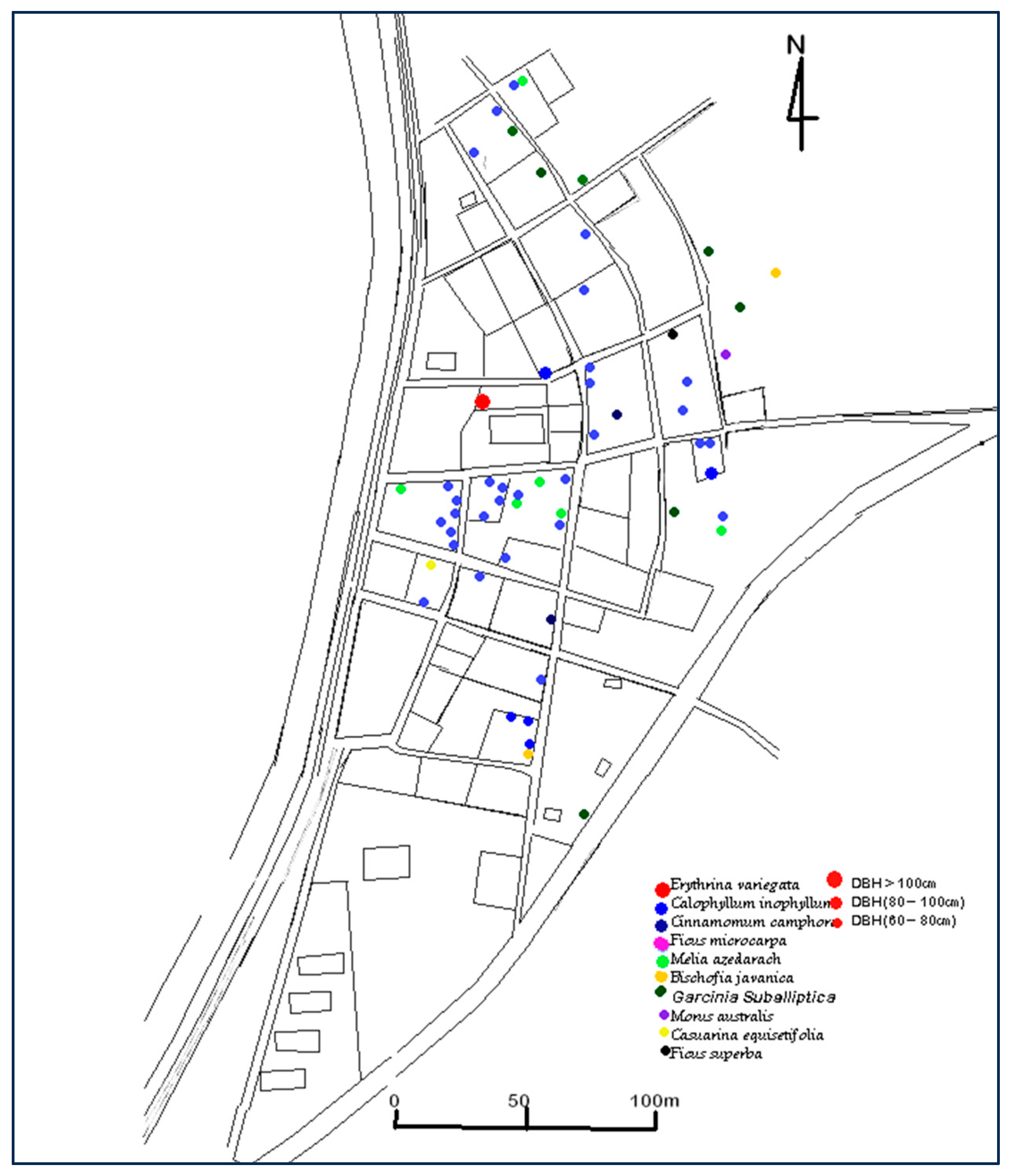
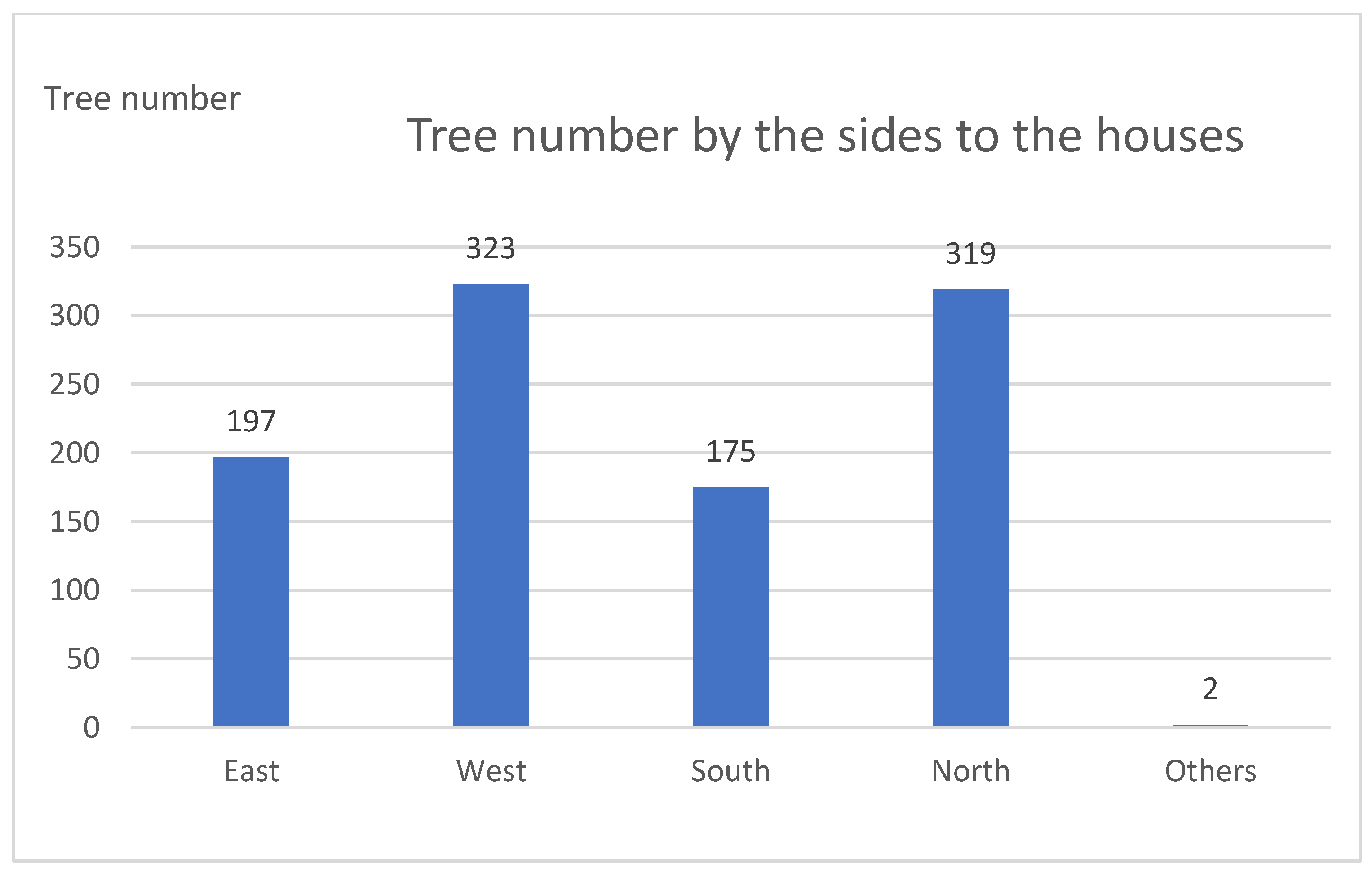
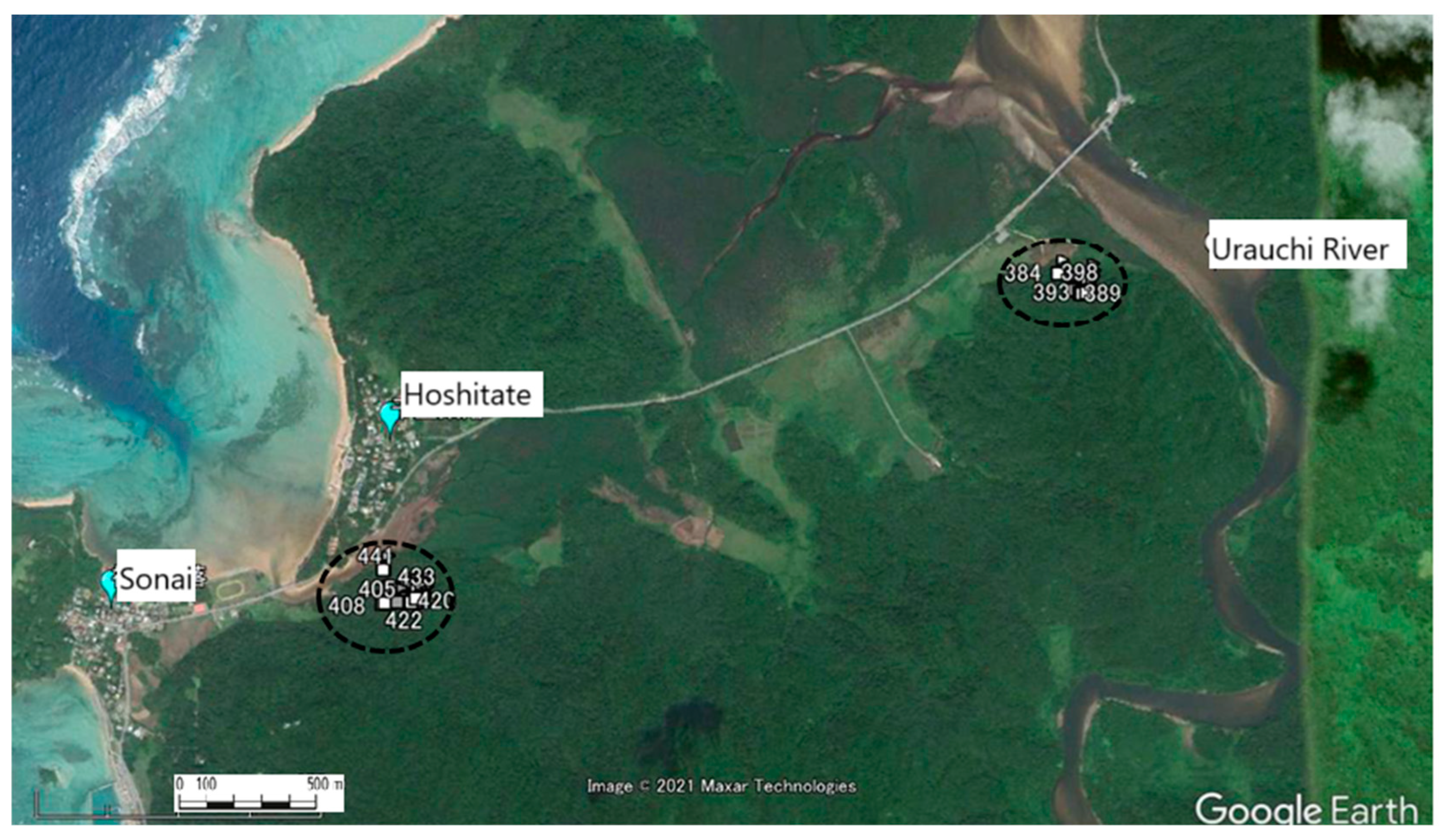

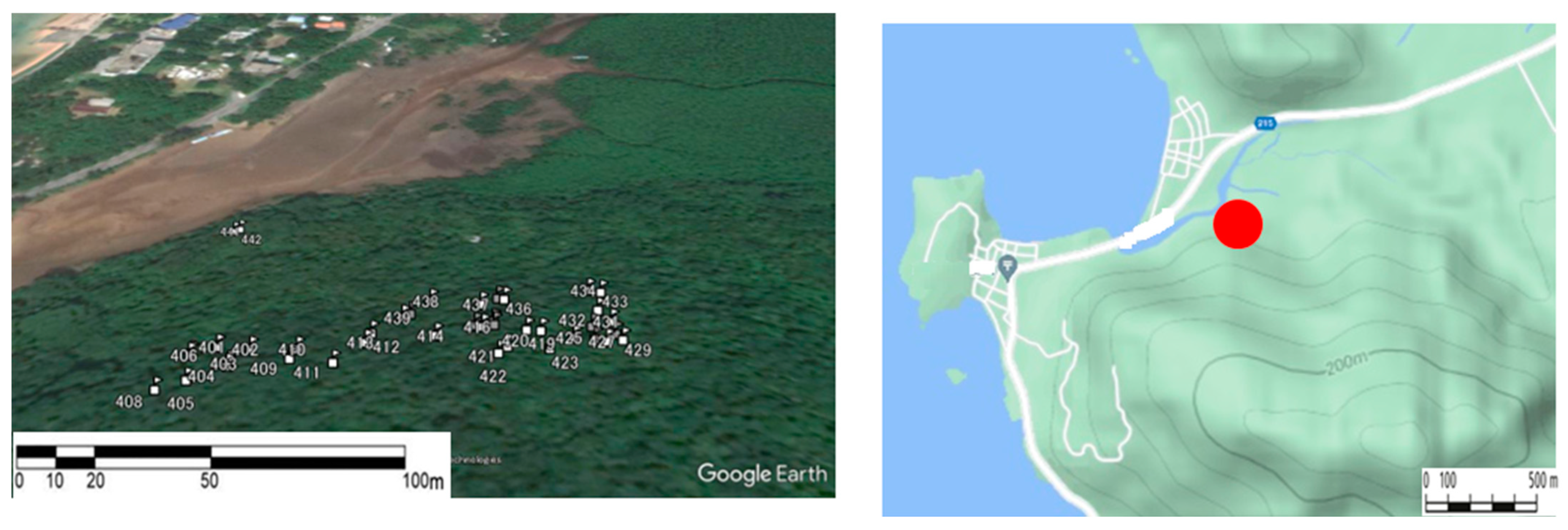
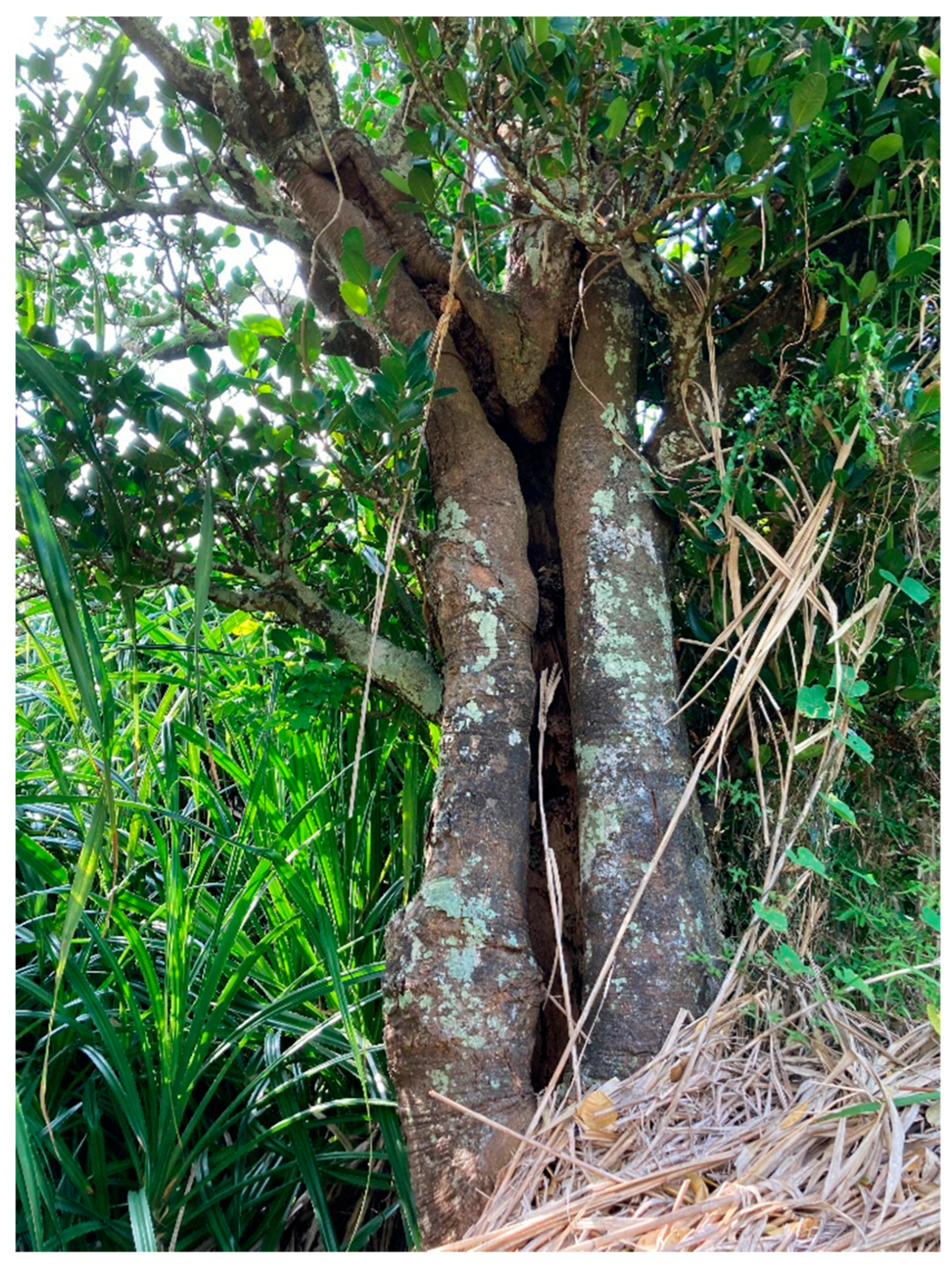
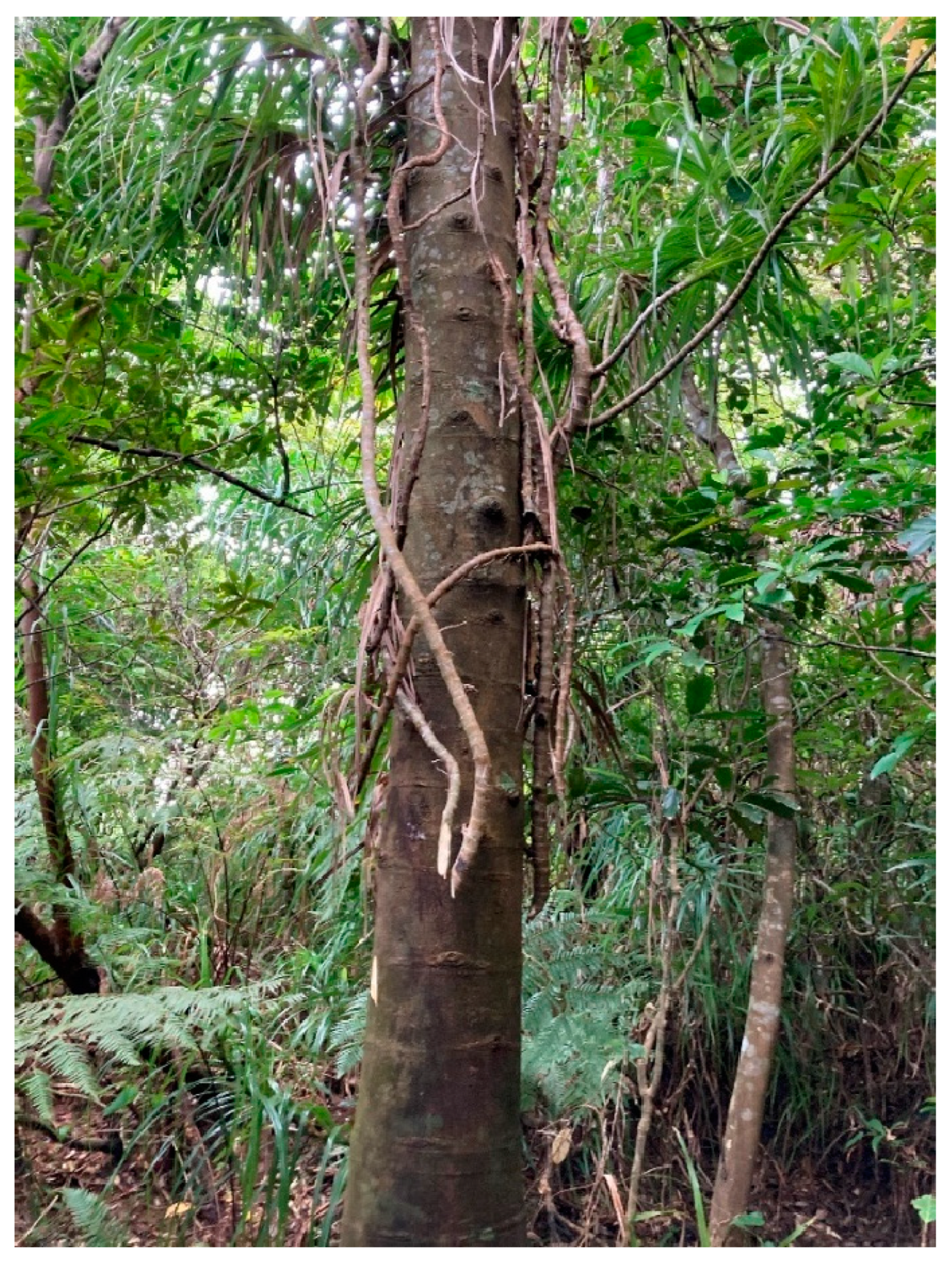
| Tree Height (m) | DBH (cm) | Estimated Age (Years) | |
|---|---|---|---|
| Tree number | 686 | 679 | 669 |
| Average | 6.20 | 20.7 | 82.8 |
| Std. Dev. | 2.50 | 14.0 | 55.9 |
| Max | 18.52 | 68 | 272 |
| Min | 0.33 | 5 | 20 |
| 5th Percentile | 2.51 | 7.4 | 6 |
| 25th Percentile | 4.34 | 12 | 10.1 |
| 50th Percentile | 5.95 | 19.5 | 16.4 |
| 75th Percentile | 7.78 | 31.7 | 27.5 |
| 90th Percentile | 9.61 | 49 | 41.2 |
| Species | No | Average DBH (cm) | Total Basal Area (m3) |
|---|---|---|---|
| Garcinia subelliptica | 340 | 24.9 | 16.491 |
| Calophyllum inophyllum | 224 | 37.8 | 25.134 |
| Diospyros ferrea | 102 | 13.1 | 1.376 |
| Planchonella obovata | 81 | 19.1 | 2.320 |
| Podocarpus macrophyllus | 40 | 15.2 | 0.721 |
| Murraya paniculata | 38 | 10.5 | 0.329 |
| Morus australis | 32 | 29.2 | 2.137 |
| Bischofia javanica | 16 | 33.8 | 1.436 |
| Melia azedarach | 15 | 54.5 | 3.491 |
| Ficus microcarpa | 13 | 33.2 | 1.123 |
| Macaranga tanarius | 11 | 18.0 | 0.279 |
| Melanolepis multiglandulosa | 10 | 14.2 | 0.158 |
| Premna serratifolia | 10 | 8.6 | 0.058 |
| Ficus septica | 8 | 12.2 | 0.093 |
| Cinnamomum camphora | 7 | 36.7 | 0.739 |
| Terminalia catappa | 7 | 20.6 | 0.234 |
| Nageia nagi | 7 | 12.7 | 0.089 |
| Citrus depressa | 7 | 8.1 | 0.036 |
| Cinnamomum pedunculatum | 6 | 9.2 | 0.040 |
| Mangifera indica | 5 | 16.1 | 0.102 |
| Diospyros maritima | 4 | 8.4 | 0.022 |
| Codiaeum variegatum | 4 | 8.2 | 0.021 |
| Ficus superba | 3 | 55.5 | 0.725 |
| Psidium guajava | 3 | 9.2 | 0.020 |
| Celtis boninensis Koidz | 2 | 9.4 | 0.014 |
| Pittosporum tobira | 2 | 9.3 | 0.014 |
| Euonymus japonicus | 2 | 5.5 | 0.005 |
| Erythrina variegata | 1 | 114.0 | 1.020 |
| Casuarina equisetifolia | 1 | 78.0 | 0.478 |
| Litchi chinensis | 1 | 28.0 | 0.062 |
| Machilus thunbergii | 1 | 23.0 | 0.042 |
| Arecaceae | 1 | 22.5 | 0.040 |
| Bauhinia variegata | 1 | 15.5 | 0.019 |
| Trema orientale | 1 | 13.2 | 0.014 |
| Euonymus tanakae Maxim | 1 | 12.5 | 0.012 |
| Callicarpa japonica | 1 | 11.8 | 0.011 |
| Distylium racemosum | 1 | 11.5 | 0.010 |
| Eriobotrya japonica | 1 | 9.4 | 0.007 |
| Pouteria campechiana | 1 | 9.0 | 0.006 |
| Gardenia jasminoides | 1 | 7.0 | 0.004 |
| Location | Number | Max (cm) | Mean (cm) | Standard Deviation (cm) |
|---|---|---|---|---|
| Urauchi River upstream | 21 | 48 | 12.8 | 10.7 |
| Hoshitate Village back mountain | 45 | 35 | 10.3 | 8.1 |
Disclaimer/Publisher’s Note: The statements, opinions and data contained in all publications are solely those of the individual author(s) and contributor(s) and not of MDPI and/or the editor(s). MDPI and/or the editor(s) disclaim responsibility for any injury to people or property resulting from any ideas, methods, instructions or products referred to in the content. |
© 2025 by the authors. Licensee MDPI, Basel, Switzerland. This article is an open access article distributed under the terms and conditions of the Creative Commons Attribution (CC BY) license (https://creativecommons.org/licenses/by/4.0/).
Share and Cite
Chen, B.; Minor, J. Key Ecological and Cultural Characteristics of Homestead Windbreak Forest Landscapes in Okinawa, Japan. Forests 2025, 16, 103. https://doi.org/10.3390/f16010103
Chen B, Minor J. Key Ecological and Cultural Characteristics of Homestead Windbreak Forest Landscapes in Okinawa, Japan. Forests. 2025; 16(1):103. https://doi.org/10.3390/f16010103
Chicago/Turabian StyleChen, Bixia, and Jesse Minor. 2025. "Key Ecological and Cultural Characteristics of Homestead Windbreak Forest Landscapes in Okinawa, Japan" Forests 16, no. 1: 103. https://doi.org/10.3390/f16010103
APA StyleChen, B., & Minor, J. (2025). Key Ecological and Cultural Characteristics of Homestead Windbreak Forest Landscapes in Okinawa, Japan. Forests, 16(1), 103. https://doi.org/10.3390/f16010103







